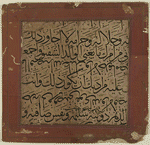| PREVIOUS | NEXT | NEW SEARCH |
Selections of Arabic, Persian, and Ottoman Calligraphy

|
Spousal advice
AUTHOR/CREATOR
Calligrapher: 'Abdallah (Lahuri)
CREATED/PUBLISHED
18th century
NOTES
Dimensions of Written Surface: 18.4 (w) x 17.6 (h) cm
Script: thuluth
This calligraphic fragment includes six lines of script written right-side-up and up-side-down in thuluth script in black ink on a beige sheet of folio pasted to a orange sheet backed by cardboard. The sequence of lines goes as follows:
First line of text: line 2 / Second line of text: line 4 / Third line of text: line 6 / Fourth line of text: line 5 (up-side-down) / Fifth line of text: line 3 (up-side-down) / Sixth line of text: line 1
Together, the six continuous lines of text in Arabic read: A father speaks to a mother [and says] this is what is joyful to a tender and loving father and one who knows that this behavior is desirable. You, as their mother, must be a sound, healthy, and pure soul; you should implement these [manners] as my will in God's following; you should spend within what God limits in your life; and you should accept what is given, what is permitted and forbidden, and you must not disobey this.
These husbandly recommendations seek to promote goodness and piety in a woman who is also a mother. The saying belongs to the broader category of advice (nasihat) in Arabic moral literature.
The fragment is signed up-side-down between the last two lines of text. The "servant" calligrapher 'Abdallah states that he has written this piece (mashaqahu al-'abd 'Abdallah), but he does not provide a date. The calligrapher may be identified as 'Abdallah Lahuri, who was active in Lahore during the 18th century. Another fragment of his work executed in nasta'liq script, is also held in the collections of the Library of Congress (1-04-713.19.43). After the death of Aurangzeb (d. 1707), Mughal power was decentralized and royal patronage of calligraphy declined. The rise of new styles emerged in cities like Lucknow, Hyderabad, and Lahore, where calligraphers such as 'Abdallah sought out patronage from local rulers and seem to have had the freedom to experiment with a number of different calligraphic scripts.
SUBJECT
Arabic script calligraphy
Illuminated Islamic manuscripts
Islamic calligraphy
Spousal Advice
Arabic calligraphy
Islamic manuscripts
Thuluth
MEDIUM
25.2 (w) x 23.5 (h) cm
CALL NUMBER
1-04-713.15.1
REPOSITORY
Library of Congress, African and Middle Eastern Division, Washington, D.C. 20540
DIGITAL ID
ascs 001
http://hdl.loc.gov/loc.amed/ascs.001
| PREVIOUS | NEXT | NEW SEARCH |